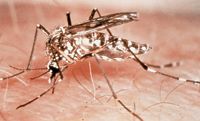- Acne
- Actinic Keratosis
- Aesthetics
- Alopecia
- Atopic Dermatitis
- Buy-and-Bill
- COVID-19
- Case-Based Roundtable
- Chronic Hand Eczema
- Chronic Spontaneous Urticaria
- Drug Watch
- Eczema
- General Dermatology
- Hidradenitis Suppurativa
- Melasma
- NP and PA
- Pediatric Dermatology
- Pigmentary Disorders
- Practice Management
- Precision Medicine and Biologics
- Prurigo Nodularis
- Psoriasis
- Psoriatic Arthritis
- Rare Disease
- Rosacea
- Skin Cancer
- Vitiligo
- Wound Care
Article
Mosquito abatement, effective repellents key to eradicating West Nile Virus
Newport Beach, Calif. — The West Nile Virus outbreak in New York City in 1999 provided important lessons in prevention, abatement and repellent use. The New York area health departments quickly began public health programs, according to Tissa R. Hata, M.D., speaking at the Pacific Dermatology Meeting, here.

"People need to be educated about transmission and what attracts mosquitoes to them," says Dr. Hata, assistant professor of dermatology at the University of California, San Diego. "Dermatologists also need to be made aware of effective repellents and how to use them in conjunction with sunscreen," she adds.
Mosquitoes develop in standing water, which can be fresh, salt or brackish. Females lay several hundred eggs at a time and the eggs hatch within two to three days. The larvae feed on organic matter in water for one week and then metamorphose into adult mosquitoes. They can feed on birds, animal and humans.
In the initial outbreak of the West Nile Virus in New York City, there were a total of 59 cases in which patients required hospitalization, many in older adults. Fever (90 percent), weakness (56 percent) and nausea (53 percent) were the most common symptoms in those hospitalized patients, but the occurrence of neurologic symptoms was also worrisome. "Keep in mind however - only one in five people infected will develop flu-like symptoms which are transient, and one in 150 will develop the neurologic symptoms requiring hospitalization," Dr. Hata says.
West Nile cases move westward Once seen as limited to the Northeastern United States, cases of West Nile Virus have dramatically moved westward between 1999 and 2004, according to Dr. Hata.
Between 1999 and 2001, West Nile Virus cases moved westward to states just east of the Mississippi River. That pattern expanded in 2003, when Colorado had the largest number of cases nationally. "Better abatement has killed the larvae there and brought cases down from nearly 3,000 in 2003 to only 225 this year," she says. California is now the state with the largest number of cases - and those cases have been escalating throughout the year. As of August 2004, there were only 79 reported cases, but 507 cases have been reported to date.
Prevention Although many people think they are the most likely to be bitten, adults are more likely to be bitten than children; young adults and middle-aged adults over the elderly; men more likely than women; and large-size versus small-size individuals. Of course, people cannot change their demographics or body composition, but they can adopt some important prevention strategies, Dr. Hata says.
A first-line prevention strategy is to try to minimize stimuli that attract mosquitoes, according to Dr. Hata. Visual stimuli are important at far range. Dark clothing is especially attractive. Besides visual cues, mosquitoes rely on thermal and olfactory signals to locate a host. Over a close range, olfactory stimulation is important. Fragrances in perfumes, soaps and hair products also attract mosquitoes.
DEET (also known as N,N-diethyl-meta-toluamide) repellents are the most effective repellents to prevent mosquito bites, according to Dr. Hata. DEET is effective against mosquitoes, biting flies, chiggers, fleas and ticks. Developed by scientists at the U.S. Department of Agriculture in 1946, after 24 years of testing over 20,000 compounds, no other compound has been shown to be as effective. There is a broad range in protection time of the DEET repellents, ranging from 88 minutes for Off! Skintastic Kids (SC Johnson, Inc) to 301 minutes for OFF! Deep Woods (SC Johnson, Inc). Contrary to popular opinion, Citronella (10 percent) only offers protection for 19 minutes. Skin-So-Soft Bug Guard (Avon) provides 23 minutes of protection. Dr. Hata also discusses other repellent products with Dermatology Times, such as wristbands. She says that these have absolutely no value.
Newsletter
Like what you’re reading? Subscribe to Dermatology Times for weekly updates on therapies, innovations, and real-world practice tips.











